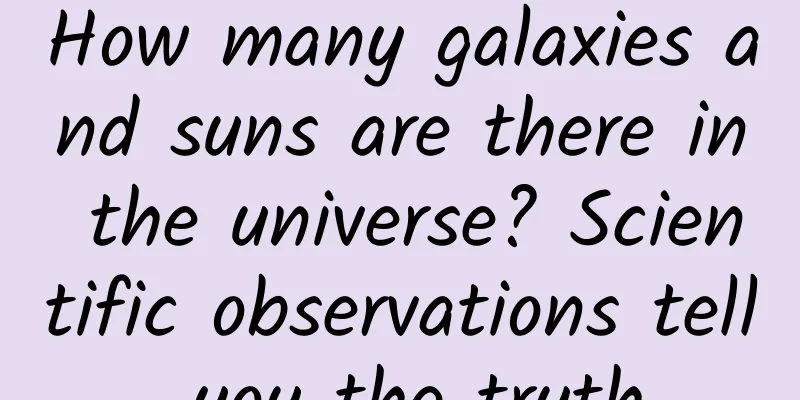How many galaxies and suns are there in the universe? Scientific observations tell you the truth

|
This article is based on answering similar questions from netizens, see the screenshot below: As soon as I saw this question, I knew it was asked by someone who doesn't have much knowledge of astronomy, but this spirit of willingness to learn and get to the bottom of things is very good, I give it a thumbs up. Let's first clarify two errors in the question. The first is how many "Milky Ways" there are in the universe. There are many galaxies in the universe, but the Milky Way refers specifically to the galaxy we are in, so there is only one. There may be many galaxies in the universe that are similar to the Milky Way, but there cannot be a galaxy that is exactly the same as the Milky Way. Even if there is, it would not be called the Milky Way, because the Milky Way is just a name given by humans to the galaxy where they live. The second is the problem that every "galaxy" has a "sun". The sun refers specifically to the only main star in the planetary system where our Earth is located. There is only one sun in the entire Milky Way. Just like the questioner is called so-and-so, there is only one sun in the whole of China. In other galaxies, our "sun" does not exist, just like the questioner does not exist in other countries. If the sun mentioned by the questioner refers to solar-type stars, there are many of them in the Milky Way and in other galaxies as well. Stars are classified by mass. The mass of the sun is 1.9891*10^30kg (kilograms or kilograms). Astronomy refers to stars with a mass of about 0.8 to 1.2 times that of the sun as yellow dwarfs. The official scientific name for yellow dwarfs is GV stars, which are main sequence stars with a spectrum of G type and a luminosity of V. The core of this type of star is continuously undergoing nuclear fusion from hydrogen to helium, and the surface temperature is between 5300 and 6000K. There are about 400 billion stars in the Milky Way, of which yellow dwarfs account for about 20%, or about 80 billion. Do other galaxies have suns? As I just said, there is only one galaxy in the universe called the Milky Way, and there is only one star called the Sun. But there are many, many galaxies in the universe, many galaxies similar to the Milky Way, and each galaxy has many stars similar to the Sun. The modern standard model theory of the universe holds that the universe was born about 13.8 billion years ago and exploded from an infinitely small singularity. Since the birth of the universe, it has been expanding at superluminal speed. The radius of the observable universe is now about 46.5 billion light-years. Starting with Galileo, humans used telescopes to observe the starry sky and discovered that the stars seen in the sky are basically outside the solar system, stars similar to the sun, just different in size; later people discovered that these stars are almost all in the same galaxy, and scientists called this galaxy that contains our home the Milky Way; later, it was discovered that there are many, many galaxies outside the Milky Way. As a result, the universe known to humans has become larger and larger, forming a layered celestial structure. In this structure, the smallest is the Earth and the Moon, called the Earth-Moon system; then there is the solar system, which consists of eight planets and hundreds of dwarf planets, satellites, countless asteroids, and comets, with a radius of about 1 light year; and the sun is just an ordinary one among the 400 billion stars in the Milky Way. The Milky Way has a diameter of about 200,000 light years and is one of the more than 50 galaxies in the Local Group, which in turn is a member of the Local Supercluster. The Local Supercluster contains hundreds of galaxy clusters (groups) covering an area of about 100 million light years. The largest galaxy cluster is the Virgo Cluster, which contains at least 2,500 galaxies. The supercluster's structure is the Laniakea Supercluster, which contains at least 100,000 galaxies; above that are structures that extend as far as tens of billions of light years. These galaxies are large and small, and the Milky Way is just one of the medium-sized galaxies. Small galaxies have about 10 billion stars, such as the Large Magellanic Cloud, which is the closest to us; large galaxies are much larger than we can imagine, such as a galaxy that has been discovered 3 billion light-years away from us, with a diameter 160 times that of the Milky Way and a mass of about 240 billion times that of the Milky Way. Astronomers named this galaxy after the giant "Alcyoneus" in ancient Greek mythology. If the star structure there is similar to that of the Milky Way, the number of stars would be about 960 trillion. There is no galaxy in these galaxies that is exactly like the Milky Way, nor a star that is exactly like the solar system, but there are certainly many similar galaxies and stars. Therefore, there are many galaxies like the Milky Way in the universe, and countless stars like the sun. How many galaxies and stars are there in the universe? At least until now, no one knows how many galaxies there are in the universe. However, we can refer to some amazing photos taken by the Hubble telescope to expand our imagination of the number of galaxies in the universe. This set of photos is called: Hubble Deep Field (HDF), Hubble Super Deep Field (HUDF), Hubble Extreme Deep Field (XDF). Now, we only know the last two photos, which are enough to explain this problem. The Hubble Super Deep Field, also known as the Hubble Ultra Deep Field, or HUDF for short, is the result of data collected by the Hubble telescope from September 24, 2003 to January 16, 2004, over a period of more than three months. The data was collected by focusing on a single location, a small area in the constellation Fornax, with a visible area of about 3 square arc minutes, equivalent to 1/12.7 million of the entire celestial sphere. After careful identification, it was found to contain at least 10,000 galaxies. This tiny target passed through the densely packed gaps of stars in the Milky Way, avoiding all celestial bodies in the Milky Way, so the photos show distant galaxies. This is the most far-reaching cosmic scene ever captured by the Hubble telescope using a visible light camera, with the farthest galaxy 13 billion light-years away from us. According to the number of galaxies shown in this photo and the principle of cosmic isotropy, that is, the conclusion that the density of galaxies in all directions is similar, there are at least 10,000*12,700,000 galaxies in the entire observable universe, or 127 billion galaxies. The Hubble Extreme Deep Field, also known as the Hubble Extreme Deep Field, abbreviated as XDF, was released by NASA on September 25, 2012. This is the Hubble Telescope pointed at a small patch of sky in the southern sky. The diameter of the field of view is less than one-tenth of the full moon. It uses the Advanced Camera for Surveys and the third-generation Wide-area Camera, with a viewing angle extending to the near-infrared region. It has been observing for 50 days, with a cumulative exposure of more than 2 million seconds, and took a composite of more than 2,000 photos. This photo has a smaller viewing area than HUDF, about one 32 millionth of the entire celestial sphere, but it displays more 75% more galaxies than HUDF, which means there are at least 560 billion galaxies in the universe! According to NASA, the youngest galaxies in the XDF photo are galaxies that were born about 450 million years ago. A large number of exceptionally bright blue giant stars can be seen, which are galaxies in their infancy. If we calculate based on the age of the universe, which is 13.8 billion years old, these galaxies are more than 13.3 billion light-years away from us. This is the most distant information that humans have ever obtained, indicating that humans are getting closer and closer to the beginning of the universe. NASA claims that the recently launched Webb telescope can move humans' eyes closer to the beginning of the universe by more than 200 million light years, thus being able to see what the universe looked like 200 million years after the Big Bang. Did galaxies form at that time? We will have to wait and see. Therefore, when scientists say that there are trillions of galaxies in the universe, it is not just a random statement, but an estimate based on a large amount of observational evidence and theoretical arguments. Today's astronomers believe that there are at least 2 trillion to 10 trillion galaxies in the observable universe. The scientific community does not know how big the unobservable universe is outside the observable universe, so we may never know how many galaxies there are in the entire universe. Each galaxy is home to billions of stars, including tens of billions of solar-like stars, so we don't know how many stars there are in the universe, nor how many solar-like stars there are. That’s all for today. If you have any opinions, please feel free to discuss. Thank you for reading. The copyright of Space-Time Communication is original. Infringement and plagiarism are unethical behavior. Please understand and cooperate. |
<<: Often feel weak and listless? Maybe you are not eating right...
>>: It’s not wrong to want to “lie down”, the “lazy cancer gene” is innate!
Recommend
The price was cut in half in just one month. Has the Bitcoin bubble really burst?
According to Reuters, on Wednesday, the price of ...
Implement a WeChat message withdrawal capture function with Python 80 lines of code
Ever since WeChat released this message recall fu...
3 fission techniques to quickly acquire customers at low cost!
Since 2017, online traffic has become more and mo...
What are the functions of Foshan Automobile Mini Program? How much does it cost to develop a WeChat car mini program?
In 2021, China's car ownership will reach 350...
The correct way to gain weight in autumn: eat more of these and less of those
People often say "bitter summer", which...
Ubuntu's first desktop-integrated phone is coming
[[151074]] As we all know, Canonical has been wor...
The milk here has been poisoning people for more than 100 years, and the root cause is still unknown
When you arrive in a new place, your safety will ...
The most detailed video promotion method!
Introduction: With the vigorous development of mo...
Dongfeng Peugeot 4008 also publicly reduced its configuration. Does the official still owe us a price cut?
Yesterday, 91che reported the news that Dongfeng ...
If you are angry, just vent it out? It turns out that we have been doing it wrong all along.
It is inevitable to feel angry and furious in dai...
How to build your first machine learning model on your iPhone
introduction As a data scientist, I have always h...
Old wine in old bottles, Cadillac CT6 with minor facelift may not have more expectations
The automotive industry also has its own rules fo...
From the perspective of "user experience", "cost" and "revenue", which one has a better future, Mobike or ofo?
Restore the user usage scenario: Register, log in...
Is intermittent fasting, which has been repeatedly "deified", a "code for renewal" or a "health trap"?
Produced by: Science Popularization China Author:...
Will Douban Movies, which is undergoing transformation, be swallowed up by BAT after being cannibalized?
You are criticizing Douban, and you are saying ho...









